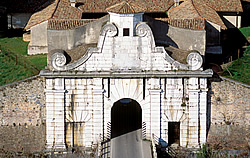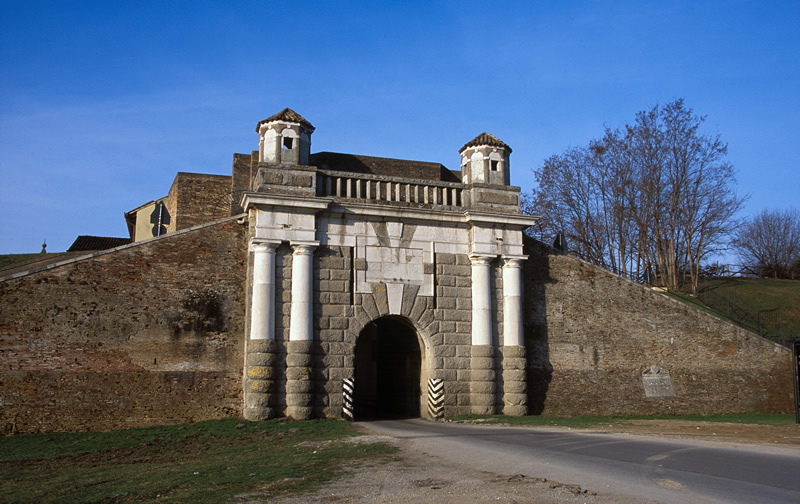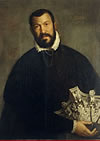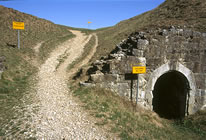 PORTA UDINE (1604-1605)
This was built, together with Porta Cividale, in 1605. This gate houses two big wheels which were used to lift the drawbridge.
PORTA UDINE (1604-1605)
This was built, together with Porta Cividale, in 1605. This gate houses two big wheels which were used to lift the drawbridge.  PORTA AQUILEIA O MARITTIMA This was the first Porta to be built (1598). The external façade is refined by two vaults that embrace the sentry box. Under the sentry box on the moulding there was the great St. Mark’s Lion made of stone which was demolished by the French in 1797.
PORTA AQUILEIA O MARITTIMA This was the first Porta to be built (1598). The external façade is refined by two vaults that embrace the sentry box. Under the sentry box on the moulding there was the great St. Mark’s Lion made of stone which was demolished by the French in 1797.  PORTA CIVIDALE (1604-1605) This Porta, along with Porta Udine, was built in 1605. It has a simpler line than the Porta Marittima.
PORTA CIVIDALE (1604-1605) This Porta, along with Porta Udine, was built in 1605. It has a simpler line than the Porta Marittima.
You may enter the Town of Palmanova through the three Monumental Gates attributed to Vincenzo Scamozzi; not for a detailed document which proved the paternity of the work by the great architect of Vicenza, but for the important role he played when he was at the service of Venice, for his documented presence in Palmanova, and above all for the treatise he wrote “Dell’idea dell’Architettura Universale” (About the Idea of the Universal Architecture) (1615)
The Gates are the only buildings visible from the outer Fortress and partly preserved the original architectonic characteristics.
The outer facade, of accurate making, contrasts with the severity and simplicity of the inner forms, which enhance, instead, the rather military practical function.
They show a common structure: on the ground floor a central squared courtyard is crossed by the leading path; two triple arch colonnade, fitted with niches with a chimney each; some pathways to the Guardhouse and to the excisemen’s locals.
Two heavy iron railings (now set in the main square under the Loggia) and 4 wings of larch with metal knobs made the access to town even safer.
Under an architectonic profile the three outer facades differ in style.

The rivellinos in front of the gates, were built in the second half of 1600, and determined a new way to enter the Fortress.
On the two sides, between these fortifications and the ditch, two counter-gates were built for different purposes. The first defended the covered path which ran around the rivellino, the second was used for the passage of charts and people, therefore it had a wider roadway. On the ditch edge, these transit counter-gates had a Guardhouse and some slits for the fusiliers.
They were fitted with railings and fortified outside by a dry ditch closed by a “ponte levadore”(drawbridge). Two of these counter-gates are still visible nowadays: Porta Aquileia and Porta Cvidale, they were both used to control the covered pathway. Only few relics and traces are left of Porta Udine.